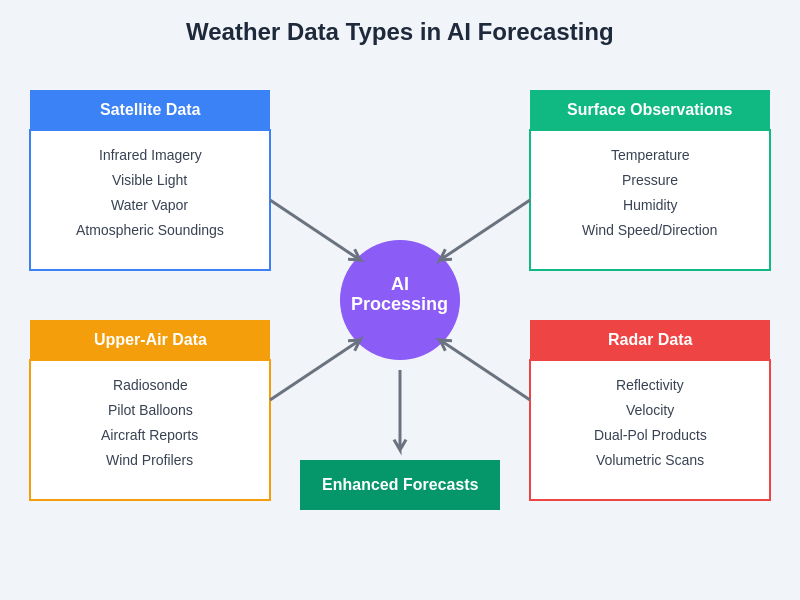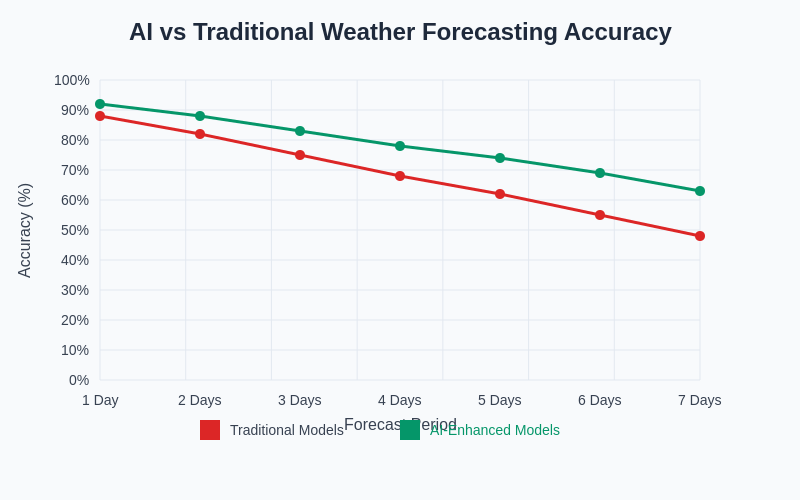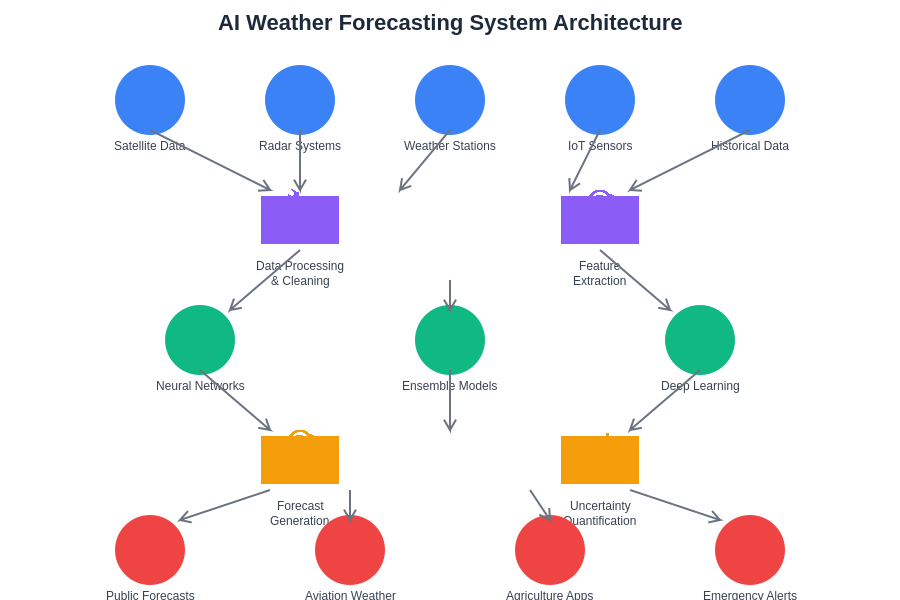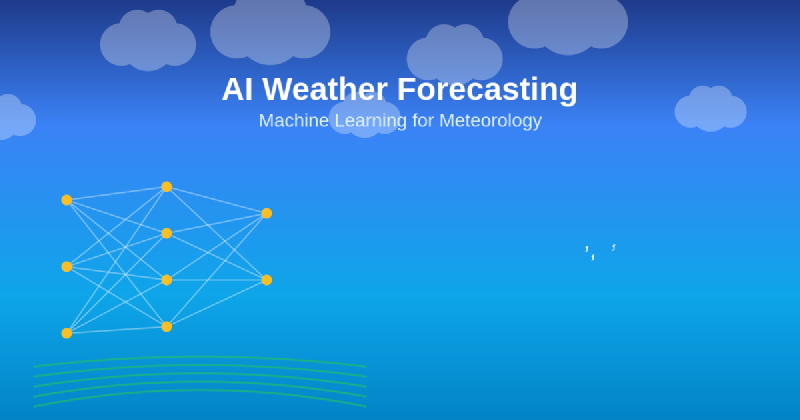The intersection of artificial intelligence and meteorology has created one of the most transformative applications of machine learning in recent decades, fundamentally reshaping how we understand, predict, and respond to weather patterns across the globe. Traditional weather forecasting, while remarkably sophisticated, has historically been constrained by computational limitations and the inherent complexity of atmospheric systems. However, the emergence of advanced machine learning algorithms, neural networks, and AI-powered data processing has opened unprecedented opportunities for improving forecast accuracy, extending prediction horizons, and understanding climate dynamics in ways that were previously impossible.
Explore cutting-edge AI applications in weather science to discover the latest innovations that are revolutionizing meteorological research and practical weather forecasting. The transformation of weather prediction through artificial intelligence represents not merely an incremental improvement in existing methodologies but a fundamental paradigm shift that is redefining the boundaries of what is possible in atmospheric science and climate modeling.
The Evolution from Traditional to AI-Powered Meteorology
Traditional weather forecasting has relied heavily on numerical weather prediction models that solve complex mathematical equations describing atmospheric behavior. These models, while sophisticated, require enormous computational resources and are limited by the resolution of input data and the accuracy of initial atmospheric conditions. The introduction of machine learning into meteorology has addressed many of these limitations by providing alternative approaches that can identify patterns in vast datasets, learn from historical weather observations, and make predictions based on complex relationships that may not be apparent through traditional mathematical modeling.
Machine learning algorithms excel at processing enormous volumes of meteorological data from satellites, weather stations, radar systems, and atmospheric sensors, extracting meaningful patterns that would be impossible for human meteorologists to identify manually. This capability has enabled the development of hybrid forecasting systems that combine the physical understanding embedded in traditional numerical models with the pattern recognition capabilities of artificial intelligence, resulting in more accurate and reliable weather predictions across various temporal and spatial scales.

The comprehensive integration of diverse meteorological data sources through artificial intelligence creates a unified processing framework that leverages the strengths of each data type while compensating for individual limitations and observational gaps.
The integration of AI into meteorology has also democratized access to sophisticated forecasting capabilities, enabling smaller meteorological organizations and developing nations to benefit from advanced prediction technologies without requiring massive investments in computational infrastructure and specialized expertise. This democratization has profound implications for global weather prediction networks and the ability to provide accurate forecasts in regions where traditional meteorological infrastructure may be limited.
Machine Learning Algorithms Transforming Weather Prediction
The application of diverse machine learning algorithms to meteorological problems has revealed the unique strengths of different approaches for various aspects of weather forecasting. Deep neural networks have proven particularly effective for processing satellite imagery and radar data, enabling more accurate identification of storm systems, precipitation patterns, and atmospheric features that are crucial for short-term and medium-range forecasting. These networks can automatically extract complex features from meteorological data that might be missed by traditional analysis methods, leading to improved detection of severe weather events and better understanding of atmospheric dynamics.
Ensemble learning methods have revolutionized probabilistic forecasting by combining predictions from multiple machine learning models to provide more robust and reliable forecasts with uncertainty quantification. This approach addresses one of the fundamental challenges in weather prediction: the inherent uncertainty in atmospheric systems and the need to communicate forecast confidence to end users. By leveraging multiple models and algorithms, ensemble methods can provide valuable insights into forecast reliability and help meteorologists make more informed decisions about weather warnings and public communications.
Discover advanced AI reasoning capabilities with Claude for complex data analysis tasks that require sophisticated pattern recognition and predictive modeling capabilities. The synergy between different machine learning approaches has created opportunities for developing specialized forecasting systems optimized for specific weather phenomena, geographical regions, or temporal scales.
Reinforcement learning has emerged as a powerful tool for optimizing weather prediction systems and improving forecast accuracy through continuous learning from forecast performance. These algorithms can automatically adjust model parameters, select optimal input features, and refine prediction strategies based on observed forecast errors, creating adaptive forecasting systems that continuously improve their performance over time. This self-improving capability represents a significant advancement over traditional static forecasting models that require manual tuning and periodic updates.
Enhanced Data Processing and Pattern Recognition
The volume and complexity of meteorological data have grown exponentially with the deployment of advanced satellite systems, weather radar networks, and atmospheric monitoring instruments. Traditional data processing methods struggle to handle this information overload and extract meaningful insights from the diverse array of data sources available to modern meteorologists. Machine learning algorithms excel at processing heterogeneous data types, from satellite imagery and radar reflectivity to atmospheric soundings and surface observations, creating comprehensive representations of atmospheric conditions that inform more accurate predictions.
Computer vision techniques have revolutionized the analysis of meteorological imagery, enabling automated detection and tracking of weather systems, cloud formations, and atmospheric phenomena across multiple spectral bands and temporal sequences. These capabilities have improved the accuracy of nowcasting systems that provide very short-term forecasts for aviation, agriculture, and emergency management applications. The ability to automatically identify and characterize weather features in satellite and radar data has also enhanced the consistency and objectivity of meteorological analysis, reducing the potential for human error in weather interpretation.
Natural language processing applications in meteorology have improved the communication of weather information to the public and facilitated the integration of textual weather observations and reports into forecasting systems. These technologies can automatically parse and interpret weather observations from various sources, extract relevant meteorological information from social media and news reports, and generate human-readable forecast summaries that effectively communicate complex weather information to diverse audiences.
Improving Forecast Accuracy and Extending Prediction Horizons
One of the most significant achievements of AI-powered weather forecasting has been the measurable improvement in forecast accuracy across various temporal scales and meteorological phenomena. Machine learning models have demonstrated superior performance in predicting specific weather events such as precipitation occurrence and intensity, temperature extremes, and severe weather outbreaks. These improvements have direct practical implications for agriculture, transportation, energy management, and emergency preparedness, where accurate weather predictions can prevent economic losses and protect human safety.
The extension of useful prediction horizons through machine learning has opened new possibilities for long-range planning and decision-making in weather-sensitive industries. While traditional numerical models typically provide reliable forecasts for periods up to one week, machine learning approaches have shown promise for extending skillful predictions to two weeks or longer for certain meteorological variables and geographical regions. This extension of prediction capability has significant implications for seasonal planning, resource allocation, and climate adaptation strategies.

The measurable improvements in forecast accuracy demonstrate the tangible benefits of artificial intelligence integration across all prediction time scales, with particularly notable gains in medium-range forecasting where traditional methods experience rapid skill degradation.
Machine learning has also improved the prediction of extreme weather events, which are often poorly represented in traditional numerical models due to their rarity and the complex physical processes involved. By training on large datasets of historical extreme weather events and learning to identify the atmospheric patterns associated with severe weather, AI systems can provide earlier warnings and more accurate predictions of hurricanes, tornadoes, heat waves, and other high-impact weather phenomena.
Enhance your research capabilities with Perplexity for comprehensive analysis of meteorological data and climate research that requires access to diverse information sources and advanced analytical capabilities. The integration of multiple data sources and machine learning algorithms has created opportunities for developing specialized prediction systems for specific extreme weather events.
Satellite Data Analysis and Remote Sensing Applications
The proliferation of meteorological satellites and advanced remote sensing instruments has created unprecedented opportunities for monitoring atmospheric conditions and improving weather predictions through AI-powered data analysis. Machine learning algorithms can process vast quantities of satellite data in real-time, extracting meteorological information from multiple spectral channels, identifying cloud types and properties, and tracking the evolution of weather systems across global and regional scales.
Deep learning approaches have proven particularly effective for analyzing satellite imagery, enabling automated classification of cloud types, detection of atmospheric features, and estimation of meteorological variables such as precipitation rates, wind speeds, and atmospheric moisture content. These capabilities have improved the initialization of numerical weather prediction models by providing more accurate and comprehensive observations of atmospheric conditions, particularly over oceanic regions where traditional surface-based observations are sparse.
The integration of multiple satellite datasets through machine learning has enhanced the spatial and temporal resolution of meteorological observations, enabling more detailed monitoring of weather systems and better understanding of atmospheric processes. AI algorithms can combine information from geostationary and polar-orbiting satellites, microwave and infrared sensors, and active and passive remote sensing instruments to create comprehensive representations of atmospheric conditions that inform more accurate weather predictions.
Climate Modeling and Long-Range Forecasting
The application of machine learning to climate modeling and long-range forecasting represents one of the most challenging and potentially impactful areas of AI meteorology. Traditional climate models require enormous computational resources and are limited by our understanding of complex climate feedbacks and interactions. Machine learning approaches offer alternative methodologies for climate prediction that can identify patterns in historical climate data, learn relationships between different climate variables, and make projections about future climate conditions.
Neural networks trained on decades of climate observations have shown promise for predicting seasonal climate patterns, such as El Niño and La Niña events, monsoon variability, and regional temperature and precipitation anomalies. These predictions have significant implications for agriculture, water resource management, and disaster preparedness, enabling more effective long-term planning and adaptation strategies in climate-sensitive sectors.
The integration of machine learning with traditional climate models has created hybrid systems that combine the physical understanding embedded in climate models with the pattern recognition capabilities of AI algorithms. These hybrid approaches can improve the representation of sub-grid scale processes, enhance model parameterizations, and provide more accurate projections of regional climate change impacts.
Severe Weather Detection and Early Warning Systems
The development of AI-powered severe weather detection and early warning systems has significantly improved public safety and emergency preparedness capabilities. Machine learning algorithms can analyze real-time meteorological data from multiple sources, including radar, satellite, and surface observations, to identify the formation and development of severe weather events with greater accuracy and earlier lead times than traditional detection methods.
Tornado detection algorithms based on machine learning have demonstrated superior performance compared to traditional radar-based detection methods, reducing false alarm rates while maintaining high detection probabilities. These improvements have significant implications for tornado warning systems and public safety, enabling more targeted and effective emergency communications while reducing warning fatigue among the public.
Hurricane track and intensity prediction has also benefited from machine learning approaches that can process multiple data sources and identify complex relationships between atmospheric conditions and storm development. AI-powered hurricane prediction systems have shown improved accuracy in forecasting storm tracks, intensity changes, and landfall timing, providing valuable information for evacuation planning and emergency resource allocation.
Agricultural and Environmental Applications
The application of AI weather forecasting to agriculture has created opportunities for precision farming and improved crop management through more accurate and localized weather predictions. Machine learning algorithms can process high-resolution meteorological data and provide farm-specific forecasts that inform decisions about planting, irrigation, fertilization, and harvesting. These applications have significant implications for agricultural productivity, resource efficiency, and food security in an era of changing climate conditions.
Pest and disease prediction models based on machine learning can identify environmental conditions that favor the development and spread of agricultural pests and diseases, enabling proactive management strategies that reduce crop losses and minimize pesticide use. These models integrate weather forecasts with biological models of pest and disease development, providing farmers with actionable information about potential threats to their crops.
Environmental monitoring and air quality forecasting have also benefited from machine learning approaches that can predict pollution levels, wildfire behavior, and other environmental hazards based on meteorological conditions. These applications have important implications for public health, environmental management, and regulatory compliance in urban and industrial areas.
Aviation and Transportation Weather Services
The aviation industry has been one of the primary beneficiaries of AI-enhanced weather forecasting, with machine learning algorithms improving the prediction of turbulence, icing conditions, thunderstorms, and other weather hazards that affect flight safety and efficiency. These improvements have enabled more accurate flight planning, reduced delays and cancellations, and enhanced safety margins for commercial and general aviation operations.
Turbulence prediction models based on machine learning can analyze atmospheric data and identify conditions that lead to different types of turbulence, providing pilots and air traffic controllers with more accurate information about potential hazards along flight routes. These predictions enable more effective route planning and altitude selection, reducing passenger discomfort and potential aircraft damage from severe turbulence encounters.
Ground transportation applications of AI weather forecasting include road weather prediction systems that provide information about icing, visibility, and precipitation conditions for highway maintenance and traffic management. These systems help transportation agencies optimize resource allocation for winter maintenance operations and provide travelers with accurate information about road conditions and travel safety.
Energy Sector Applications and Grid Management
The integration of renewable energy sources into electrical grids has created new demands for accurate weather forecasting, particularly for solar and wind energy production predictions. Machine learning algorithms can process meteorological data and provide detailed forecasts of solar irradiance and wind speeds at specific energy production facilities, enabling more effective grid management and energy trading strategies.
Wind power forecasting using machine learning has demonstrated significant improvements in prediction accuracy compared to traditional methods, particularly for short-term forecasts that are crucial for grid balancing and energy market operations. These improvements have economic implications for renewable energy producers and grid operators, enabling more efficient utilization of wind resources and reducing the need for backup power generation.
Solar energy forecasting through AI algorithms can predict cloud movements and solar radiation levels with high spatial and temporal resolution, providing valuable information for solar power plant operators and grid managers. These predictions enable more effective energy storage management and grid integration strategies for large-scale solar installations.
Real-Time Processing and Nowcasting Systems
The development of real-time weather analysis and nowcasting systems has been revolutionized by machine learning algorithms that can process streaming meteorological data and provide immediate updates on weather conditions and short-term forecasts. These systems are particularly valuable for applications that require rapid response to changing weather conditions, such as aviation operations, emergency management, and outdoor event planning.
Nowcasting systems based on machine learning can analyze radar data and satellite imagery to track the movement and evolution of precipitation systems, providing accurate predictions of rainfall intensity and location for the next few hours. These capabilities have improved flood warning systems, urban drainage management, and agricultural decision-making in regions where short-term precipitation forecasts are crucial for operations.
The integration of multiple real-time data sources through machine learning has enhanced situational awareness for meteorologists and emergency managers, providing comprehensive views of current weather conditions and near-term forecast evolution. These integrated systems enable more effective coordination of emergency response activities and public warning communications during severe weather events.
Global Weather Data Integration and Analysis
The challenge of integrating meteorological observations from diverse sources and platforms around the world has been addressed through machine learning approaches that can harmonize data from different instruments, resolution scales, and quality standards. These integration capabilities have improved the global weather observing system and enhanced the accuracy of weather predictions in data-sparse regions.
International collaboration in AI meteorology has facilitated the sharing of machine learning models, training datasets, and best practices across national meteorological services and research institutions. This collaboration has accelerated the development and deployment of AI-powered weather forecasting systems and improved the consistency and quality of weather predictions on a global scale.
Quality control and bias correction of meteorological observations using machine learning have improved the reliability of weather data and enhanced the performance of numerical weather prediction models. These automated quality control systems can identify and correct systematic errors in observations from various sources, ensuring that high-quality data are used for weather analysis and forecasting.

The systematic integration of multiple data sources and processing stages through artificial intelligence creates a comprehensive forecasting pipeline that maximizes the value of available meteorological information while maintaining operational efficiency and reliability.
Future Developments and Emerging Technologies
The continued advancement of artificial intelligence and machine learning technologies promises to bring even more sophisticated capabilities to meteorological applications in the coming years. Quantum computing applications in weather prediction may enable the processing of even larger datasets and more complex algorithms, potentially revolutionizing the accuracy and efficiency of weather forecasting systems.
Edge computing and distributed AI systems will enable more localized processing of meteorological data and real-time analysis of weather conditions at unprecedented spatial and temporal resolutions. These developments will improve the accuracy of hyperlocal weather forecasts and enable new applications in urban meteorology, microclimate analysis, and precision agriculture.
The integration of Internet of Things sensors and crowdsourced weather observations with machine learning algorithms will create opportunities for enhancing weather monitoring networks and improving forecast accuracy through increased observational coverage. These distributed sensing networks will provide more detailed information about weather conditions in urban areas, remote regions, and other locations where traditional meteorological infrastructure is limited.
Explainable AI techniques will address the current limitations of black-box machine learning models in meteorology by providing insights into how AI systems make weather predictions and which factors are most important for different types of forecasts. This transparency will improve confidence in AI-powered weather predictions and enable better integration with traditional meteorological expertise and decision-making processes.
The convergence of AI weather forecasting with other emerging technologies, such as autonomous vehicles, smart cities, and precision agriculture, will create new opportunities for integrated environmental monitoring and decision support systems. These integrated systems will provide comprehensive information about weather impacts on various sectors and enable more effective adaptation and response strategies for weather-related challenges.
Disclaimer
This article is for informational purposes only and does not constitute professional meteorological or technical advice. The information presented is based on current understanding of artificial intelligence applications in weather forecasting and meteorology. Weather prediction involves inherent uncertainties, and readers should rely on official meteorological services and qualified professionals for weather-related decisions. The effectiveness and accuracy of AI-powered weather forecasting systems may vary depending on geographical location, weather phenomena, and specific implementation details.
